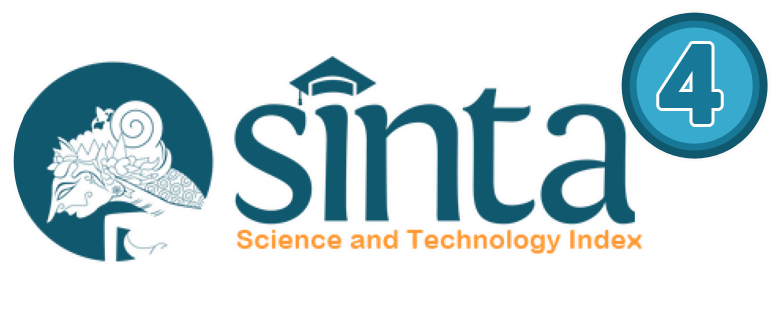Al-Kalimât al-'Arabiyah al-Dakhîlah fî al-Lughah al-Indûnîsiyah Lafdzhan wa Ma'nan wa Atsaruhâ fî Ta'lîm al-Lughah al-'Arabiyah
 Abstract views: 309
,
Abstract views: 309
,
 PDF downloads: 718
PDF downloads: 718
Abstract
This study discusses Arabic words which are absorbed into Indonesian. The research background of this study is that teachers feel difficult to choose the right content to achieve appropriate goals for foreign beginners, prepare good educational materials for them, determine what should be first started from the lesson materials and show the discussions that require deep concentration. The method used to realize this research was a literature study by using documents such as Arabic and Indonesian books. It was analyzed using deductive and inductive analysis accurately until becoming independent analysis. The result showed that Arabic words which are absorbed into Indonesian in pronouncing and it's meaning are Arabic words that are entered in Indonesian without changing the pronunciation (lafadz) and it's meaning. There are two hundred and fifteen words that have been presented in this research, and most of them come from jamid or Mushtaq names. It has effects generally which include words absorption and others and it also has an effect specifically toward words absorption only.
Downloads
References
إبراهم مصطفى وأحمد حسن الزيات وغيرهما، المعجم الوسيط (استنبول: دار المعارف أو دار الدعوة، 1980م).
أحمد علي إبراهيم اللافي، التطور الدلالي والتطور الصوتي والدخيل في اللغة اللعربية (مالانج: رسالة الماجستير قسم اللغة العربية، جامعة مولانا مالك إبراهيم الإسلامية الحكومية، 2015م).
أحمد فؤاد أفندي، آفاق تاريخية للغة العربية في إندونيسيا/هذا الكتاب في ضمن كتاب اللغة العربية في إندونيسيا (الرياض: دار وجوه للنشر والتوزيع، 2015م).
بطرس بن جبرائيل يوسف عوّاد، مجلة لغة العرب العراقية (بغداد: مطبعة الآداب).
جودة حسنين جودة وفتحي محمد أبو عيانة، قواعد الجغرافيا العامة الطبيعية والبشرية (دار المعرفة الجامعية).
رشدي أحمد طعيمة، المرجع في تعليم اللغة العربية للناطقين بلغة أخرى (مكة المكرمة: جامعة أم القرى، 1986م).
عبد الرحمن بن أبي بكر، الإتقان في علوم القرآن (الهيئة المصرية العامة للكتاب،1974).
عبد الغني أبو العز م، معجم الغني (مصدر الكتاب: مكتبة شاملة، موقع معاجم صخر).
عبد النصير أحمد الشافعي، ردع الأوغاد عن موالاة الكفار والتشبه بهم وتهنئتهم بالأعياد (إندونيسيا: منارة أهل السنة، 2018م).
علي بن محمد، كتاب التعريفات (لبنان: دار الكتب العلمية، 1983).
مجموعة من المؤلفين، مجلة جامعة أم القرى19-24(مكتبة شاملة، بترقيم الشاملة آليا).
محمد ضياء وعبد الله بن نوح، الإسلام في أندونيسيا (دار السعودية للنشر والتوزيع، 1977م).
Aceng Abd Aziz & Sulton Fathoni & Zemzemi, dan yang lainnya, Islam Ahlu Al-sunnah Wa Al-jamaah: Sejarah pemekiran dan dinameka Nahdlotu Al-Ulama’ di Indonesia (Pengurus lembaga pedidikan Ma’arif Nahdlatul Ulama’ pusat, 2016).
Ahmad Warson Munawwir, Kamus Al-Munawwir (Pustaka Progressif, 1997).
Al-Khuli, M. A, Strategi Pembelajaran Bahasa Arab (Yogyakarta: Cetakan 1; B. Subhan & Khasanaedi, eds, basan Publishing ,2010).
Hidayah, Milatul, Fransiscus Xaverius Samingin, and Asri Wijayanti. "Kata Serapan bahasa Arab dalam Kosakata Bahasa Indonesia sebagai Materi Pembelajaran Ceramah di Kelas XI SMA: Kajian Bidang Fonologi." Repetisi: Riset Pendidikan Bahasa dan Sastra Indonesia, Vol. 1, No. 2, 2018: 100-112.
Kamisa, KBBI/Kamus Besar Bahasa Indonesia, (Surabaya: Cahaya Argency, 2013).
M. A. Hamid, Baharuddin, & Mustofa, Pembelajaran Bahasa Arab (Malang: UIN-Malang Press, 2008).
Muhyidin, Asep. "Reading Interest and Mastery of Foreign Absorbing Vocabulary (Minat Baca dan Penguasaan Kosakata Serapan Asing)." Indonesian Language Education and Literature, Vol. 3, No. 2, 2018): 143-156.
Mustofa, S, Strategi Pembelajaran Bahasa Arab Inovatif (Malang: UIN-Maliki Press, 2017).
Putra, Dony Suryodi, Edy Suryanto, and Slamet Mulyono. "Kata Serapan Pada Kolom Iki Lho Di Harian Joglosemar (Pola Dan Latar Belakang Penggunaan)." Basastra, Jurnal Penelitian Bahasa, Sastra Indonesia Dan Pengajarannya 3.
Ulin Nuha, Ragam Metodologi Dan Media Pembelajaran Bahasa Arab (Yogjakarta: Diva Pres, 2016).
Authors who publish with this journal agree to the following terms:
a. Authors retain copyright and grant the journal right of first publication with the work simultaneously licensed under a Creative Commons Attribution License that allows others to share the work with an acknowledgement of the work's authorship and initial publication in this journal.
b. Authors are able to enter into separate, additional contractual arrangements for the non-exclusive distribution of the journal's published version of the work (e.g., post it to an institutional repository or publish it in a book), with an acknowledgement of its initial publication in this journal.
c. Authors are permitted and encouraged to post their work online (e.g., in institutional repositories or on their website) prior to and during the submission process, as it can lead to productive exchanges, as well as earlier and greater citation of published work (See The Effect of Open Access).
Alibbaa': Jurnal Pendidikan Bahasa Arab have CC-BY-SA or an equivalent license as the optimal license for the publication, distribution, use, and reuse of scholarly work.
In developing strategy and setting priorities, Alibbaa': Jurnal Pendidikan Bahasa Arab recognize that free access is better than priced access, libre access is better than free access, and libre under CC-BY-SA or the equivalent is better than libre under more restrictive open licenses. We should achieve what we can when we can. We should not delay achieving free in order to achieve libre, and we should not stop with free when we can achieve libre.

Alibbaa': Jurnal Pendidikan Bahasa Arab is licensed under a Creative Commons Attribution 4.0 International License
You are free to:
- Share — copy and redistribute the material in any medium or format
- Adapt — remix, transform, and build upon the material for any purpose, even commercially.
- The licensor cannot revoke these freedoms as long as you follow the license terms.











